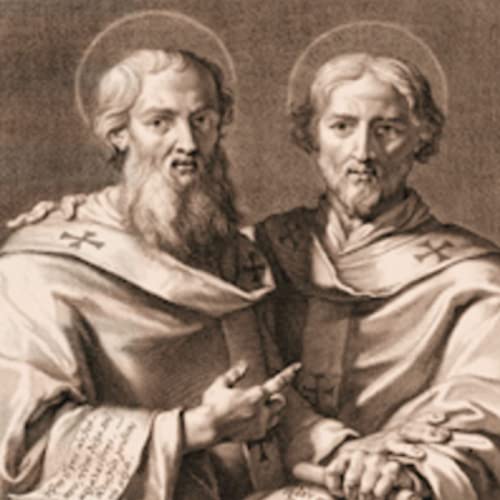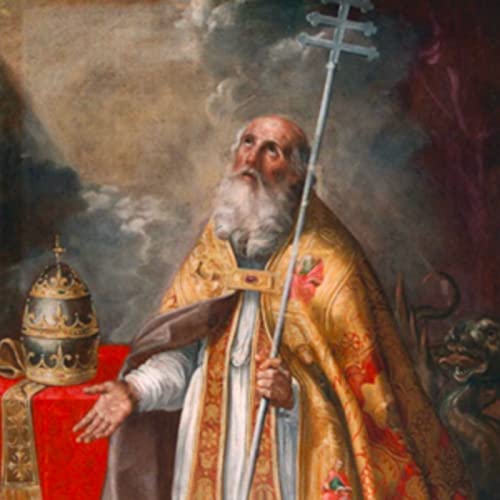December 29: Saint Thomas Becket, Bishop and Martyr
c. 1119–1170
Optional Memorial; Liturgical color: Red
Patron Saint of the clergy
Murder in the Cathedral!
Four knights hustled down the nave of England’s Canterbury Cathedral, weighed down with tackle, and found the church’s strong man. Eyes narrowed. Teeth clenched. Hard words were spit back and forth. Tempers. A tussle. Then the four knights brutishly struck down Thomas Becket, his blood defiling the sanctuary. People quickly flooded the Cathedral, but no one touched the dead body, none even dared go near it. The news blew like an ill wind through all of Europe. The December spilling of an Archbishop’s blood in his own Metropolitan Cathedral, a sin joining martyrdom with sacrilege, was perhaps the most stunning deed of the High Middle Ages.
Our saint referred to himself as “Thomas of London” and said his enemies alone styled him “Becket.” He was not of noble blood and rose in the Church primarily through the patronage of an admiring Archbishop, who dispatched Thomas to Rome several times on sensitive Church-Sate missions. Thomas was appointed Chancellor by English King Henry II, cementing their warm, personal bond. Perhaps hoping friendship had softened Thomas’ resistance to the royal will, the King proposed his friend as Archbishop of Canterbury, the head of the English Church. The decision was ratified by the Pope, so Thomas, who had remained a Deacon until that point, was quickly ordained a priest and then consecrated a bishop. But his appointment to high ecclesial office poisoned Thomas’ friendship with Henry II, led to years of exile, and ultimately drove those four determined knights through the doors of Canterbury Cathedral.
Thomas Becket was a complex man in whose soul formidable virtues swirled as one with powerful vices. He was volatile, easily provoked, and vain. He relished the magnificence of his high status and travelled with a personal retinue of two hundred servants, knights, musicians, and falconers. He fought for England on the battlefield, engaging in hand-to-hand combat while vested in chain mail. But Thomas also fasted, endured severe penances, prayed devoutly, was generous with the poor, and lived a life of purity. Being ordained a bishop helped to cool his temper, abate his pride, and refine his coarser traits.
England’s two strongest men were destined to clash over their exclusive loyalties to Holy Church and Holy Realm. In 1164 King Henry II demanded significant concessions from England’s bishops: the abolishing of ecclesiastical courts, no appeals to Rome without the King’s approval, and no excommunication of landholders without the Crown’s consent. The King also imposed
higher taxes on the Church and curtailed priest’s rights. Thomas was aghast at the demands of his former friend and resisted the Crown’s demands at every step. The wick was now lit, and the flame slowly burned its way toward the explosive murder in the Cathedral.
In reaction to the King’s overreach, Thomas fled to France, met with the Pope, resigned, fretted, was reinstated, and waited. The struggle between State power and Church freedom dragged on for six years as various complex intrigues played themselves out. Thomas finally returned to England on December 1, 1170, to an admixture of hostility and joy. He would not live to the end of the month, and he knew it. In a fit of incandescent rage, King Henry II asked to be rid of Thomas, vague words taken to their most violent extreme by the four killers. When they rushed into the sanctuary, the knights shouted, “Where is Thomas the traitor?” Thomas replied, “Here I am, no traitor, but Archbishop and priest of God.” Thomas’ brains were soon washed over the floor. King Henry II did public penance, the Knights sought forgiveness from the Pope himself, and Becket was rapidly canonized. Saint Thomas Becket’s ornate tomb became a place of pilgrimage for centuries, until it was desecrated by a later King Henry, the eighth of that name, in 1538, when royal spasms once again brought violent blows down on the Church.
Saint Thomas Becket, your last few heroic minutes on earth made you a saint. Help all bishops, priests, and deacons to emulate your manly virtues in standing strong for the Church in season and out of season, whatever the cost, their whole life long.
Mehr anzeigen
Weniger anzeigen
 5 Min.
5 Min. Dec 31 20245 Min.
Dec 31 20245 Min. Dec 30 20247 Min.
Dec 30 20247 Min. 6 Min.
6 Min. Dec 27 20255 Min.
Dec 27 20255 Min. Dec 27 20246 Min.
Dec 27 20246 Min. Dec 26 20246 Min.
Dec 26 20246 Min. 7 Min.
7 Min.
